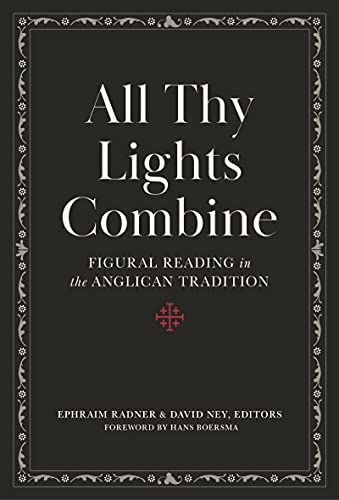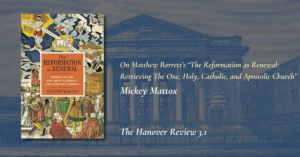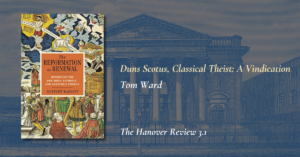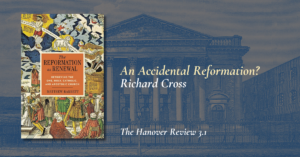All Thy Lights Combine: Figural Reading in the Anglican Tradition. Edited by Ephraim Radner and David Ney. Bellingham, WA: Lexham Press, 2022. 304 pages. Hardcover. $32.99
“Oh that I knew how all thy lights combine,
And the configurations of their glorie!
Seeing not onely how each verse doth shine,
But all the constellations of the storie.”
– George Herbert
This stanza from Herbert mines down into the very heart of the golden recesses that figural reading is intended to accomplish. Figural reading is the attempt to see how all of God’s biblical-theological lights, so to speak, combine into a singular canonical display in the Scriptures. In All Thy Lights Combine, a work that owes its title to this thought-provoking poem, Ephraim Radner and David Ney have sought to demonstrate the riches that have been figurally unearthed within the Anglican tradition. Why this particular tradition? Well, aside from being the tradition that these editors and contributors find themselves to be a part of, Anglicanism, as Radner and Ney note, has had a great influence upon almost every Christian denomination in the English-speaking world from the King James translation to its Prayer Book (14). It is in light of this influence that the editors have sought to present a modest introduction to figural reading in the Anglican tradition by surveying the reading methods of some of the tradition’s most storied personas.
Summary
Radner and Ney begin this effort with their own introduction to figural reading itself. The enterprise of “figural” reading is “the practiced version of that conviction of Scripture’s power to provide and reveal the wholeness of God’s world and history, and to absorb and include all aspects of actual life within the formative power of God’s life, most clearly given in Christ Jesus.” (3-4) The figures of Scripture thus serve to reveal what the world is really like, the world that all of us inhabit each and every day. When one reads of the judgment of the idolatrous nations throughout Scripture, for example, the contemporary consequences for societal wickedness begin to make sense. These figures are then read alongside the whole of the canonical witness with a particular eye towards how these biblical words and images, ones that we see in our own world today, fit within the broader narrative of redemption in Christ Jesus. They are a means of drawing out the continuity of God’s work across time (9). By searching the Scriptures, we are not merely reading the stories of ancient peoples. We are reading our own story. This lies at the very heart of figural reading, and one that is particularly emphasized, as will be shown across the various essays in this volume, among many figures within the Anglican tradition.
David Mason Barr introduces his piece on the great William Tyndale with a rather audacious claim. “He (Tyndale) was, in fact, not executed in 1536 for his works of translation, but for his theological views.” (26) According to Barr, it was Tyndale’s figural reading of Scripture that fueled his efforts to see Scripture translated in the English vernacular (26). If Scripture applies to all peoples in all circumstances, with the stories within revealing what our world is truly like, then it is nothing short of a crime for all peoples not to have the ability to read those biblical words. Barr demonstrates Tyndale’s figural reading of Scripture via the theologian’s arguments about the English commonwealth. Tyndale saw the various judgments of the nations throughout Scripture as figural warnings for his native home. England, like Nineveh and Israel, must repent of its wickedness and bow in worship to the one, true God (34-38). Thus, for Tyndale, figural reading served to uphold what would become the predominant understanding of Anglican political theology.
Ephraim Radner’s own personal contribution reckons with the impact of the inimitable Thomas Cranmer upon Anglican figural reading. As Radner remarks, “it was Cranmer’s goal to see the entire nation’s life divinely transfigured in accordance with the Scriptures.” (49) He saw both himself and his nation figured throughout the pages of the sacred Text. Even Job was to be understood, in his stricken and afflicted state, as a representation of the England of Cranmer’s day (54). Cranmer’s own contribution to this figural tradition lies in the Book of Common Prayer. He believed wholeheartedly that a yearly reading of Scripture, with all of its figures being consistently held before the faces of its readers, was the means by which God, the author of Scripture, would form his people and the nation of England at large into that which is promised from ages past (66). The narratives and persons within the Scriptures are a divine presentation of our own reality, and we steadily find ourselves within this story of redemption the more we immerse ourselves into its pages.
In many ways, these first two essays present the conceptual categories from which the historical persons presented in ongoing essays take their cue. Whether it be Thomas Cranmer (45-73), Richard Hooker (75-95), or noted female Anglican interpreters (255-285), the Anglican tradition clearly has been anchored deeply in the waters of figural reading. From seeing Israel’s history as a “continual allegory of Christ and the Church,” (130) to the poignant hymns of one of Anglicanism’s greatest grandchildren, if you will, (175) there is a rich practice of seeing all of Scripture, from narrative to law, as serving as the figural bedrock from which we understand the reality present before our very eyes. All of life was to be seen through the lens of the Scriptures. When one reads one of David’s psalms (106-109) or of Samson slaying his enemies in his death (244), he or she is to catch a revelatory glimpse of both their own life and that of the divine Son who has come in history to redeem sinful enemies. From the first essay to the last, Radner and Ney have structured a volume that testifies to this beautiful truth: the world of the Scriptures is, in fact, the very world that we walk in every day.
Critical Reflection
This is not the kind of work that one “critiques” per se. Every essay within is fairly straightforward in its intention to be one part of a whole. While one could always quibble with the nuances of the given definitions of figural reading and historical examples of such, that is not what I will be doing with my reflection upon All Thy Lights Combine. Rather, my aim is to reflect on what this volume provides for the modern Church, a Church so often divorced from the sort of hermeneutical enchantment that fills the pages of these essays.
The figural readings that permeate this volume exemplify a way of reading the Scriptures that fills the Christian with both humility and wonder. Within the pages of Scripture, we are constantly given pictures of who we are as fallen creatures as well as who our Divine Redeemer is. From Abel to the apostolic John in exile, the Scriptures reveal our Triune God and all things in relation to him. Whether it be the narratives of the patriarchs or the sundry laws within the Mosaic covenant, these texts all work by divine inspiration to speak of God and creation’s relationship to him. This manner of theological or figural reading is sorely needed in a modern moment too often characterized by more naturalistic and merely historical readings of biblical texts. One only needs to open recent editions of The Journal of Biblical Literature to see this on display. Modern biblical readers, whether they be a part of God’s Church or outside of it, tend to read texts in isolation from each other. Biblical narrative, for example, is often not the first place one might go in today’s world to understand a dogmatic account of anthropology or of sanctification. However, this is precisely the theological move made by the Anglican theologians and interpreters that fill the pages of All Thy Lights Combine. In Abraham, Jacob, Joseph, Ruth, David, and Solomon all saw theological figures of ourselves. They saw a divinely breathed-out reflection upon human persons in this sinful world, as well as a theological revelation of the divine Son who would bring salvation to those lying spiritually dead east of Eden. In Jonah’s sinful retreat from God’s call upon him, they saw our own failure to do the same. In his descent into that fish, they saw the descent of our Lord into the earth in order that the nations might be brought to him by faith. In the nation of Israel, they saw both England’s high calling and unjust transgressions.
In an evangelical moment filled with so much theological confusion, from anthropology to the nature of the Triune God himself, figural reading is a cool drink in our arid wilderness. Could it be that many of the theological errors of our day arise from shallow and flat readings of Scripture? In a world suffering from centuries of drinking from less-than-nutritious interpretive waters, could it be that the Church is in desperate need of a more biblically enchanted way of looking at everything around us? The answer to those questions lies in the past, and that is precisely the intention of figural reading. The answers to modern problems are not to be found in the progressive ethos. They are found in the realization that the world of the Bible is, in fact, the very world that we inhabit. The Scriptures tell us who we are and where we’re headed. They put the only hope for this fallen cosmos on display. They are the perspective from which we make sense of both the sorrowful tragedies and indescribable joys that fill our lives in this world.
What the Anglican tradition provides us is a picture of what it looks like for Christians to truly believe that God has authored a theologically cohesive Book. Anglicans have not been the only tradition to do so, and the editors make that clear, but their example is an opportunity for all of God’s Church, whether Methodist, Presbyterian, or Baptist, to continue to have their spiritual eyes opened to all that is theologically contained in every page of Scripture. The question that lies before the modern Church is not merely whether She will see the Scriptures as a theological text—theology is always done for better or for ill whenever She reads this Book—rather, the question is whether or not She will inhabit its pages, seeing its words all around her in the world that God has made. It is that question that All Thy Lights Combine so elegantly calls the Church to answer. We must pick up the Scriptures and read with biblical imagination and enchantment, seeing every text as an intentional seed that will assuredly sprout up with theological vigor in the rich canonical soil in which it’s planted. May we take up this call that our Anglican brothers and sisters have laid down by their example.
Author
-

Cody Floate (MDiv, The Southern Baptist Theological Seminary) is a PhD student at Puritan Reformed Theological Seminary doing research in theological interpretation and the Book of the Twelve. He also serves as the Exegetical Theology Editor for the London Lyceum. He and his wife Emily live in Auburn, AL where he manages a local coffee shop.



